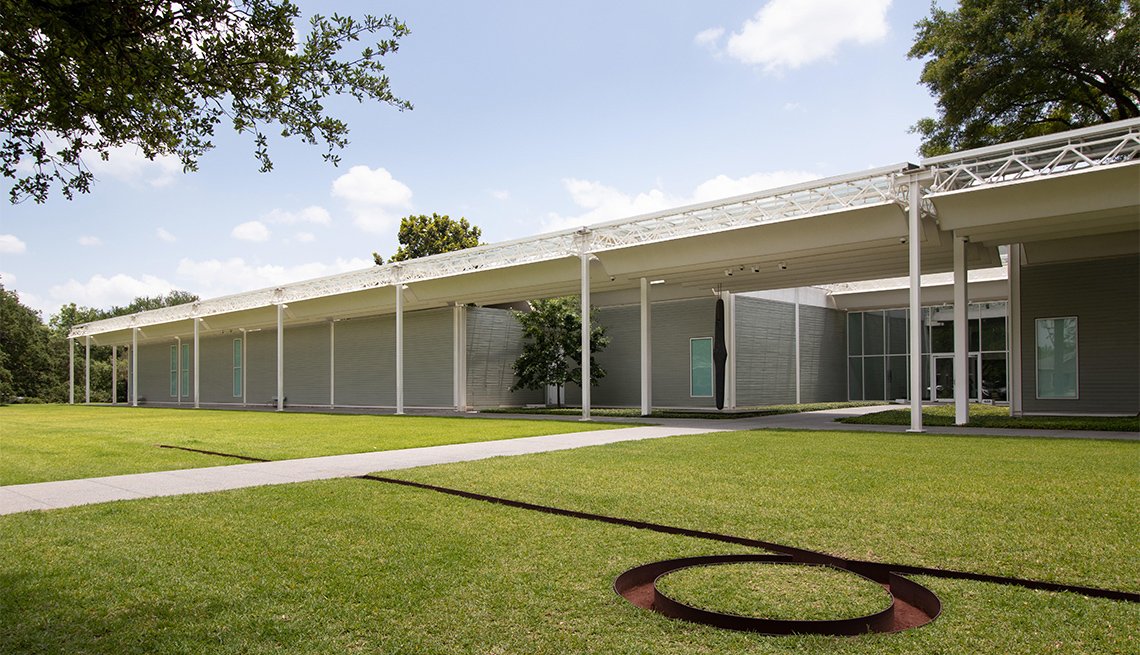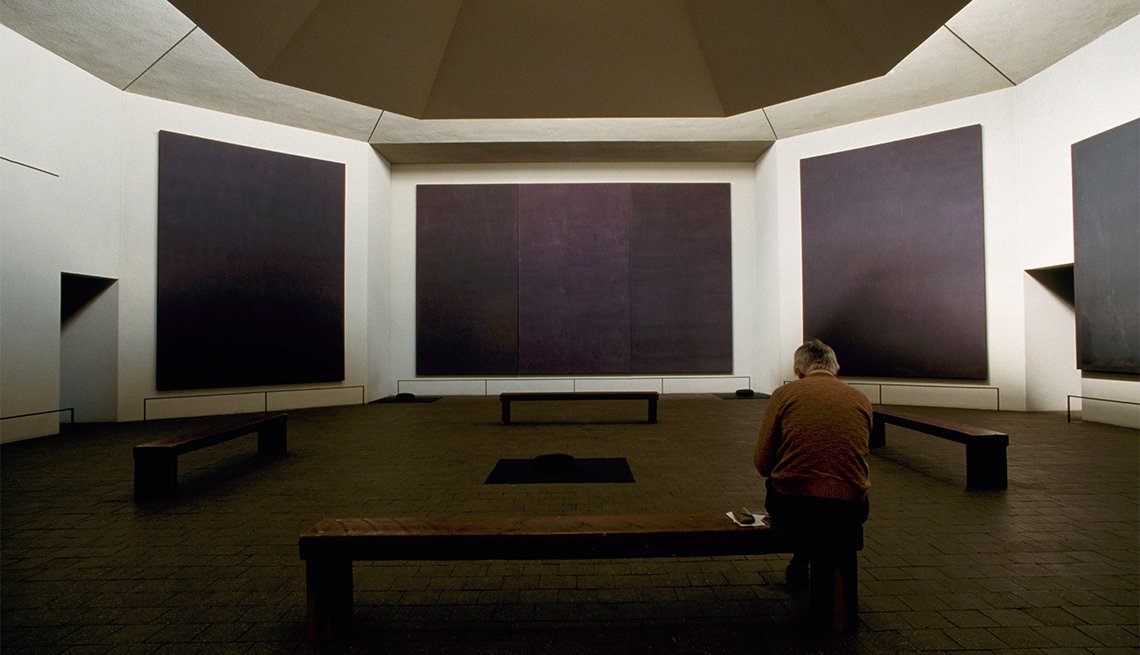By Becca Hensley
While mourning the death of my grandmother recently, I made my first visit to the Rothko Chapel in Houston. The octagonal, minimalistic sanctum, anchored by a reflective pool, looked nothing like a conventional house of worship, yet it drew me in immediately. Something healing flowed out.
In 1964, art collectors John and Dominique de Menil commissioned abstract expressionist Mark Rothko to design this ecumenical structure. Completed in 1971, a year after Rothko’s suicide, the chapel showcases 14 of this master’s paintings, each featuring a series of mysteriously dark, subtle hues: grays, purples, even greens. They took me inside myself in a grounding way — centering me on that first visit, as well as on subsequent ones.

Houston reigns as an arts and curiosities mecca, as evidenced by its prized Museum District, home to not only this chapel but 18 other institutions grouped into four walkable zones about 4 miles south of downtown. Displaying objects as varied as the largest emerald crystal found in North America, Byzantine icons and Jackson Pollock paintings, the district offers something for every mood. There’s even a 55-acre zoological park.
You can’t experience the entire district in one trip, but here’s a doable plan for a three-day museumfest.
Day 1: Rothko Chapel and the Menil Collection
Start your visit in Zone 1 at the Rothko Chapel, which celebrated its 50th anniversary in 2021 with the launch of a $30 million restoration and expansion project. The first phase has been completed, with the most dramatic change a new skylight that brings in dreamy rays of brightness, like moonbeams illuminating a garden wall. The original oculus released too much light and had been partially covered for years to darken the room, which sometimes made the chapel too shadowy for visitors to see the paintings with clarity.

Next, make the short walk through leafy Menil Park to the Menil Collection, a 30-acre museum campus with multiple buildings showcasing the wealthy de Menils’ private art collection, one of the world’s largest and most dynamic. There’s plenty to impress here, especially the African sculptures, antiquities and modern art. (Note: The term “Menil Collection” refers to the entire campus as well as to the actual cache of de Menil–owned art.)
Exhibitions rotate, drawing from the museum’s vast collection of permanent treasures, a hoard of 17,000 drawings, paintings, photos, prints, rare books and sculptures. Not meant to be comprehensive, the collection highlights the variety of artwork across centuries and cultures. Uniquely, you won’t find any explanations in the various rooms; the objects and art speak for themselves, without any commentary from experts.
Plan to spend most of your time in the main building and the Cy Twombly Gallery, two adjacent buildings designed by Renzo Piano that are themselves artworks. Their contemporary architecture contrasts uniquely with the surrounding streets’ abundance of 19th-century bungalows.
The main building stands out as the mother lode, especially for its surrealist masterworks by the likes of Max Ernst and Joan Miró. A visitor favorite: Ernst’s canny portrait of Dominique de Menil herself — it’s as if she’s watching over the gallery with pride. To deepen your understanding of what inspired the surrealists, wander into the cabinet of curiosities titled “Witnesses to a Surrealist Vision.” In this room, 150 specially curated artifacts, curios and objects from the past, including African masks, wood carvings from the Pacific Islands and musical instruments, reveal a common intelligence among early cultures, something that intrigued the surrealists. The room suggests how they borrowed shapes, subjects and themes from bygone times to create their own art.
The smaller Cy Twombly Gallery captivates with some of the abstract artist’s best work. Known for his large-scale paintings riddled with energetic scrawls and calligraphic marks, Twombly created an oeuvre that many find heart-opening and spiritual. Two quintessential pieces will catch your eye: Bay of Naples and Triumph of Galatea both portray pops of colors made with materials such as crayon, graphite and house paint. A bit like looking into the sky at the clouds or into infinity, such as the horizon over the sea, they have a mind-broadening effect.
End your visit with the traditional afternoon tea service at Bistro Menil, a European-inspired eatery that also serves brunch, lunch and dinner.
Day 2: Houston Center for Contemporary Craft
In the district’s Zone 2, the Houston Center for Contemporary Craft (HCCC) offers a casual, hands-on, immersive experience. In a renovated warehouse with an industrial-chic vibe, HCCC celebrates artworks made from clay, fiber, glass, metal and wood. Though such creations were historically defined as artisan-made functional objects, the genre has evolved. Accordingly, this clever museum redefines “craft” to encompass imaginative works of contemporary and conceptual art, with its two main galleries showcasing revolving exhibits.
HCCC engages art aficionados of all ages through its artists-in-residence program. Once a year, the museum selects artists to work in its on-site studios, and visitors are free to converse with them while they create. You might see a ceramicist throwing clay on the wheel or a fiber artist weaving on a loom.
Before leaving HCCC, unwind in its tranquil Craft Garden, an urban green space awash with plants used in making baskets, papers and textiles. They’re all labeled, with their use noted (ingredients for natural dyes come from indigo and turmeric plants, for example). The center often offers educational activities here, such as wool dying with natural colors.
Director’s tip: Tackle craft projects of your own in the museum’s Hands-On Houston program on the first Saturday of each month, a wonderful activity for families and multigenerational groups. “The small projects always result in something to take home and cherish and, hopefully, spark children and adults to imagine how more of their material world is made,” says Perry Price, the museum’s executive director.
Also in Zone 2: Visit the Holocaust Museum Houston (5401 Caroline St.), where survivors share personal accounts via interactive exhibits, recordings, art, films and photographs. You’ll also see rare artifacts that evoke the painful past, including a Holocaust prisoner’s uniform and cap and a World War II–era railcar similar to those that transported Jews to concentration camps and killing centers. Docents, the children of Holocaust survivors, share their families’ stories. The museum isn’t recommended for children under 12.

Day 3: Museum of Fine Arts, Houston
Get ready for a day of eye-popping art-gazing at the Museum of Fine Arts, Houston (MFAH), a mammoth 300,000-square-foot facility in Zone 3 with a permanent collection of approximately 70,000 works from six continents. A pedestrian plaza and three underground tunnels (themselves works of art) connect the museum’s six buildings and sculpture garden. Two house museums, the former homes of Houston philanthropists Ima Hogg and Harris and Carroll Sterling Masterson, nestle off campus in the nearby, upscale River Oaks neighborhood.
Most guests limit their visit to the three main gallery buildings. In the Audrey Jones Beck Building, arguably the most popular, the collections range from ancient to mid-20th-century art. You’ll be spellbound by impressionist paintings from the likes of Claude Monet, Pierre-Auguste Renoir and Georges Seurat. Ponder Monet’s Water Lilies for its celebration of light and Vincent van Gogh’s The Rocks for its bold brushstrokes.
The adjacent Caroline Wiess Law Building features works and objects from around the world, including Asia, Australia and the Pacific Islands. The Glassell Collections of African, Indonesian and Pre-Columbian Gold dazzle with priceless decorative objects, ancient fashion, tools and items used for currency. Pieces such as the pre-Columbian Set of 49 Plaque Ornaments in glittery gold exemplify both the exquisite artistry of ancient cultures and how status was conveyed in former times.
The newly opened Nancy and Rich Kinder Building, connected by tunnel to the Wiess Law Building, shifts attention to modern and contemporary art. With a first-floor black-box gallery specially created to display immersive installations, this building can showcase truly au courant pieces, such as an infinity room with mirrors created by Yayoi Kusama that poses questions about time, space and eternity.
Upstairs, wander through galleries featuring decorative arts, drawings, Latin American and Latino art, photography, paintings, prints and sculpture. In Pablo Picasso’s Deux femmes devant un fenêtre, note his dual use of cubism and surrealism. Marvel at Georgia O’Keeffe’s skillful depiction of spatial forms, both human and plantlike, in Grey Lines With Black, Blue and Yellow.
Austin-based travel writer Becca Hensley contributes to the New York Post, Travel + Leisure, Elite Traveler and other publications and websites.

